Mount
Pleasant Hospital
Britton Drive, North Road, Southall,
Middlesex UB1 2SH
Medical
dates:
Medical
character:
Isolation. Later, TB, then geriatric
In 1904 the Southall-Norwood
Urban District Council established an isolation hospital in North Road
for patients with scarlet fever, diphtheria and other infectious
diseases. It was named the Southall Isolation Hospital, but also
known as the Southall Fever Hospital.
The main building was later supplemented with wooden huts.
During WW2 two air-raid shelters were built.
In July 1948 the Hospital joined the NHS under the control of the Uxbridge Group Hospital Management Committee, part of the North West Metropolitan Regional Hospital Board. In September it was renamed the Mount Pleasant Hospital, after the hamlet next to which it had been built.
The Regional Hospital Board put in a scheme to convert it into a hospital for diseases of the chest. Extensive works were carried out; the air-raid shelters were made into a Day Room for the patients and a Staff Sitting Room. The garage block was converted and extended to become the operating theatres and an X-ray Department.
In 1949 the Hospital had 50 beds for male patients suffering from tuberculosis. The large gardens were maintained by two gardeners.
In 1953 a new ward block was built, which contained a ward with 29 beds, a kitchen and a Nurses' Dining Room. The new ward was named Lovibond Ward as a tribute to Mrs Kathleen Lovibond, the Chairman of the Hospital Management Committee. The new building was opened by Sir Frederick Messer, K.B.E., J.P.
The Hospital then had 79 beds, not all of which could be used because of the dire nationwide shortage of nurses. In fact, it was difficult to recruit nurses for the Hospital because of the nature of the work and the inaccessibility of the Hospital. Domestic staff were also difficult to get as husbands feared to allow their wives to work in a TB hospital.
By 1958, with the advent of antituberculous drug treatments, the number of TB patients had declined, so the Hospital was adapted for geriatric patients. One of the original ward blocks, Chard Ward, a wooden hut with 20 beds, was taken out of use as ward accommodation and was converted into a Physiotherapy and Occupational Therapy Centre. The Hospital then had 58 beds. The sanitary arrangements for the other two blocks - Lovibond and Windle Wards - were updated and other improvements were made to the wards. In 1959 cubicle tracking and curtains were provided for each bed.
In 1960 concrete fencing was built along most of the Hospital's boundary. The gardens were also improved with the addition of garden furniture, including swing hammocks.
In 1963 the wards were redecorated.
On 1st April 1965 the Uxbridge Group Hospital Management Committee was renamed the Hillingdon Hospitals Group Hospital Management Committee.
In 1974, following a major reorganisation of the NHS, the Hospital came under the control of the Hillingdon District Health Authority, part of the North West Thames Regional Health Authority.
The Hospital closed in 1990.
Present status (September 2008)
The main building was later supplemented with wooden huts.
During WW2 two air-raid shelters were built.
In July 1948 the Hospital joined the NHS under the control of the Uxbridge Group Hospital Management Committee, part of the North West Metropolitan Regional Hospital Board. In September it was renamed the Mount Pleasant Hospital, after the hamlet next to which it had been built.
The Regional Hospital Board put in a scheme to convert it into a hospital for diseases of the chest. Extensive works were carried out; the air-raid shelters were made into a Day Room for the patients and a Staff Sitting Room. The garage block was converted and extended to become the operating theatres and an X-ray Department.
In 1949 the Hospital had 50 beds for male patients suffering from tuberculosis. The large gardens were maintained by two gardeners.
In 1953 a new ward block was built, which contained a ward with 29 beds, a kitchen and a Nurses' Dining Room. The new ward was named Lovibond Ward as a tribute to Mrs Kathleen Lovibond, the Chairman of the Hospital Management Committee. The new building was opened by Sir Frederick Messer, K.B.E., J.P.
The Hospital then had 79 beds, not all of which could be used because of the dire nationwide shortage of nurses. In fact, it was difficult to recruit nurses for the Hospital because of the nature of the work and the inaccessibility of the Hospital. Domestic staff were also difficult to get as husbands feared to allow their wives to work in a TB hospital.
By 1958, with the advent of antituberculous drug treatments, the number of TB patients had declined, so the Hospital was adapted for geriatric patients. One of the original ward blocks, Chard Ward, a wooden hut with 20 beds, was taken out of use as ward accommodation and was converted into a Physiotherapy and Occupational Therapy Centre. The Hospital then had 58 beds. The sanitary arrangements for the other two blocks - Lovibond and Windle Wards - were updated and other improvements were made to the wards. In 1959 cubicle tracking and curtains were provided for each bed.
In 1960 concrete fencing was built along most of the Hospital's boundary. The gardens were also improved with the addition of garden furniture, including swing hammocks.
In 1963 the wards were redecorated.
On 1st April 1965 the Uxbridge Group Hospital Management Committee was renamed the Hillingdon Hospitals Group Hospital Management Committee.
In 1974, following a major reorganisation of the NHS, the Hospital came under the control of the Hillingdon District Health Authority, part of the North West Thames Regional Health Authority.
The Hospital closed in 1990.
Present status (September 2008)
The Hospital buildings have been demolished and the main part of the site is now occupied by Manor Court, a nursing home complex with 120 beds in 'private' grounds. An NHS Day Centre is tucked away in a corner.
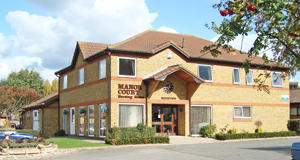
The Manor Court Nursing Home (above and below) is a purpose-built care home with four separate self-contained buildings, each with its own communal facilities.
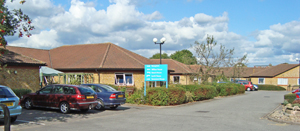
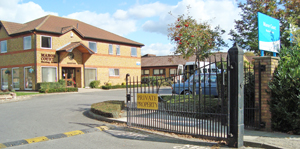
The main gates to the complex appear to be the original Hospital gates.
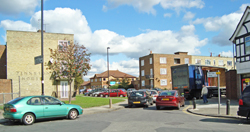
The approach to Manor Court on Britten Drive.
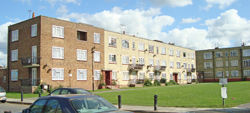
New housing on North Road outside the gates.
Wingfield H 2003 The workhouse and hospital at Hillingdon (Middlesex) 1744-1967. London, Hillingdon Hospital NHS Trust.
www.british-history.ac.uk
www.flickr.com
Return to home page